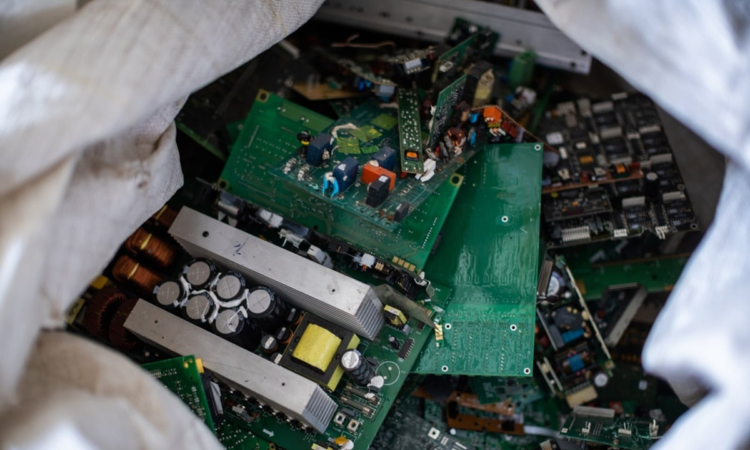
Every year millions of electrical and electronic devices are discarded as products break or become obsolete and are thrown away. These discarded devices are considered e-waste and can become a threat to the environment and to human health if they are not treated, disposed of, and recycled appropriately. Common items in e-waste streams include computers, mobile phones, and large household appliances, as well as medical equipment. Every year, millions of tonnes of e-waste are recycled using environmentally unsound techniques and are likely stored in homes and warehouses, dumped, exported or recycled under inferior conditions. When e-waste is treated using inferior activities, it can release as many as 1000 different chemical substances into the environment, including harmful neurotoxicants such as lead (3). Pregnant women and children are particularly vulnerable due to their unique pathways of exposure and their developmental status. The International Labour Organization (ILO) estimates that 16.5 million children were working in the industrial sector in 2020, of which waste processing is a subsector (4).
Electronic waste (e-waste) is the fastest growing solid waste stream in the world, increasing 3 times faster than the world’s population (1). Less than a quarter of e-waste produced globally in 2019 was known to be formally recycled; however, e-waste streams contain valuable and finite resources that can be reused if they are recycled appropriately. E-waste has therefore become an important income stream for individuals and even communities. However, people living in low- and middle-income (LMICs), particularly children, face the most significant risks from e-waste due to lack of appropriate regulations, recycling infrastructure and training. Despite international regulations targeting the control of the transport of e-waste from one country to another, the transboundary movement of e-waste to LMICs continues, frequently illegally. E-waste is considered hazardous waste as it contains toxic materials or can produce toxic chemicals when treated inappropriately. Many of these toxic materials are known or suspected to cause harm to human health, and several are included in the 10 chemicals of public health concern, including dioxins, lead and mercury. Inferior recycling of e-waste is a threat to public health and safety.
Electrical and electronic items contain many different toxic substances. While users are unlikely to have contact with any of these substances when the items are in use, when they become waste, these toxicants can be released into the environment if the devices are managed using environmentally unsound practices and activities. Several unsound practices have been observed at e-waste sites including:
These activities are considered hazardous to the environment and human health as they release toxic pollutants, contaminating the air, soil, dust, and water at recycling sites and in neighbouring communities. Burning or heating is considered one of the most hazardous activities due to the toxic fumes created. Once in the environment, toxic pollutants from e-waste or produced through unsound recycling activities can travel significant distances from the point of pollution, exposing people in faraway areas to health-damaging substances.
A range of adverse health outcomes linked to e-waste recycling activities have been posed.
Children and pregnant women are especially vulnerable to the effects of hazardous pollutants from informal e-waste recycling activities. Children are often involved in waste picking and scavenging, burning discarded e-waste and the manual dismantlement of items into component parts. In some countries, children may serve as a source of cheap labour and their small hands give them an advantage in taking apart the smallest items. These activities directly expose children to injury and high levels of hazardous chemicals. Working as a waste picker is hazardous labour and is considered one of the worst forms of child labour by the ILO. In 2020, the ILO estimated that as many as 16.5 million children globally were working in the industrial sector, of which waste processing is a subsector (4). It is unknown how many child labourers participate in informal e-waste recycling.
E-waste exposure may be linked to the following health effects during pregnancy and in infants and children:
Children and pregnant women are at higher risk than adults to contaminants released through informal e-waste recycling activities due to their unique vulnerabilities. Children have different exposures to e-waste recycling activities. E-waste recycling activities release toxic chemicals that can cross the placenta and may contaminate breastmilk, for example mercury. Additionally, children are highly sensitive to many of the pollutants released through e-waste recycling due to their rapidly developing bodies, including their respiratory, immune and central nervous systems. E-waste contains multiple known and suspected neurotoxicants, including lead and mercury, that may disrupt the development of the central nervous system during pregnancy, infancy, childhood and adolescence. Some harmful toxicants from e-waste may also impact the structural development and function of the lungs. Changes to children’s developing systems from e-waste may cause irreparable harm and affect them for the rest of their lives.
National and international actions are essential to protect communities from dangerous e-waste recycling activities. Actions that can be taken include:
The Basel Convention controls the transboundary movement of hazardous wastes and their disposal. It is a comprehensive environmental agreement that aims to tackle issues surrounding hazardous wastes, including e-waste and its management. In 2019, the Ban Amendment to the Basel Convention entered into force. It prohibits the movement of hazardous wastes, including e-waste, from countries of the Organisation for Economic Co-operation and Development (OECD), the European Commission countries and Liechtenstein to other states that are party to the Convention. The Basel Convention runs programmes and workshops to develop and deliver guidance on environmentally sound management of e-waste. It also provides states with guidelines to distinguish between waste and non-waste and the transboundary movement of e-waste. Additionally, regional conventions also exist, such as the Bamako Convention and the Waigani Convention. Both these regional conventions have arisen in response to the Basel Convention and aim to further restrict the movement of hazardous wastes, including e-waste, in African and South Pacific countries, respectively.
WHO’s Initiative on E-waste and Child Health is contributing to a number of international e-waste programmes and pilot projects in countries in Latin America and Africa. These pilot projects are developing frameworks to protect children’s health from e-waste exposures that can be adapted and replicated in other countries and settings. The Initiative aims to:
In 2021, WHO released its first global report on e-waste and child health, which called for greater effective and binding action to protect children from the growing threat. WHO has developed training tools for the health sector, such as the recently updated training package for health care providers, including a specific training module on lead and on e-waste and child health. Additionally, WHO contributes to multi-agency capacity training tools including a MOOC and a joint course with PAHO.
References
Related
WHO’s work on children’s environmental health
WHO Initiative on E-waste and Child Health (leaflet)
Children and digital dumpsites: e-waste exposure and child health
Fact sheets







